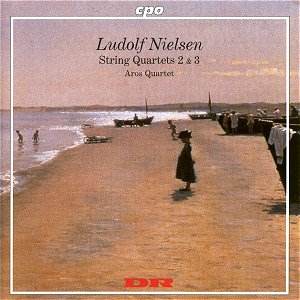Two half hour string quartets from Denmark's other
Nielsen. Ludolf Nielsen wrote three such quartets, the first, a charming
work according to note writer Jens Cornelius, dating from 1900. The
Second is suave and full of dense movement, like mid-period Beethoven
with incursions from Dvořįk (tr.2
and tr.4 00.38) as well as wrenching and yearning romance (tr.3). This
quartet never entered the Danish repertoire despite three concert presentations
by Ludolf's own ensemble, the Bjřrvig, in 1905 and two performances
by the Anton Svendsen quartet in 1913.
The Third Quartet was written at the time of
the death of his parents in 1920 from Spanish flu and with the dislocation
and horror of the Great War not far distant. It is dedicated to the
memory of his mother and father. The first of the four movements is
mobile and flowing, carefree and care-weighed; intense and serenading,
mercurial and with passing parallels with the chamber music of Herbert
Howells. The rocking second movement is fragrant with rococo elegance.
There is just enough of the powdered wigs effect to give flavour but
to avoid enervation. The Adagio con dolore is introspective and
austere, a sincere reflective song that pulls at the heart-strings.
The finale (allegro) is a fantastic play of the passions - brilliant
and tragic. The quartet was published in 1930 having been premiered
by the Budapest Quartet in Copenhagen in 1920.
Typically warm, close recording, stingingly emotive
playing, full of energetic poignancy. The Third Quartet is a remarkable
work with a deeper reach than Ludolf's three symphonies which usually
strike me as 'pictorial' in the manner of Goldmark's Rustic Wedding,
Smetana's Festive and Børresen's Second and Third. Bless
the Aros and CPO for rediscovering the fiery life in these pages and
in the even more emotionally demanding Third.
Rob Barnett

